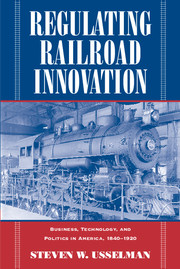Part I - ASSEMBLING THE MACHINE, 1840–1876
Published online by Cambridge University Press: 12 August 2009
Summary
American railroading began as a series of localized experiments with an unproven technology of revolutionary potential. In cities up and down the Atlantic Coast, groups of enthusiasts sought to acquire sufficient expertise and capital to patch together lines that would penetrate the hinterland. Promoters of these pioneering ventures never perceived the railroad as merely a means of transportation. From the start, they embraced it as an engine of change that would alter the character of economic activity. This desire to spark economic diversification and stimulate growth infused railroading with a sense of public purpose. Though most lines were funded primarily by private capital, virtually all received substantial legal privileges from local and state governments. Employing various mixes of public incentives and private initiatives, cities and regions engaged in a developmental rivalry, with the railroad as the lever of growth. The goal was not so much to race westward to a common destination and compete for the same pool of traffic, but to build an infrastructure and foster a healthy regional commerce that would lure capital and human resources away from other locales.
The abundance of sparsely settled land sustained this developmental phase far longer in the United States than in most other places that adopted the railroad. Long after railroading in many European nations had attained a measure of maturity in which a few well-established routes were used ever more intensively, westward expansion continued to open new opportunities for Americans looking to exploit the revolutionary developmental potential of railroading.
- Type
- Chapter
- Information
- Regulating Railroad InnovationBusiness, Technology, and Politics in America, 1840–1920, pp. 13 - 14Publisher: Cambridge University PressPrint publication year: 2002

